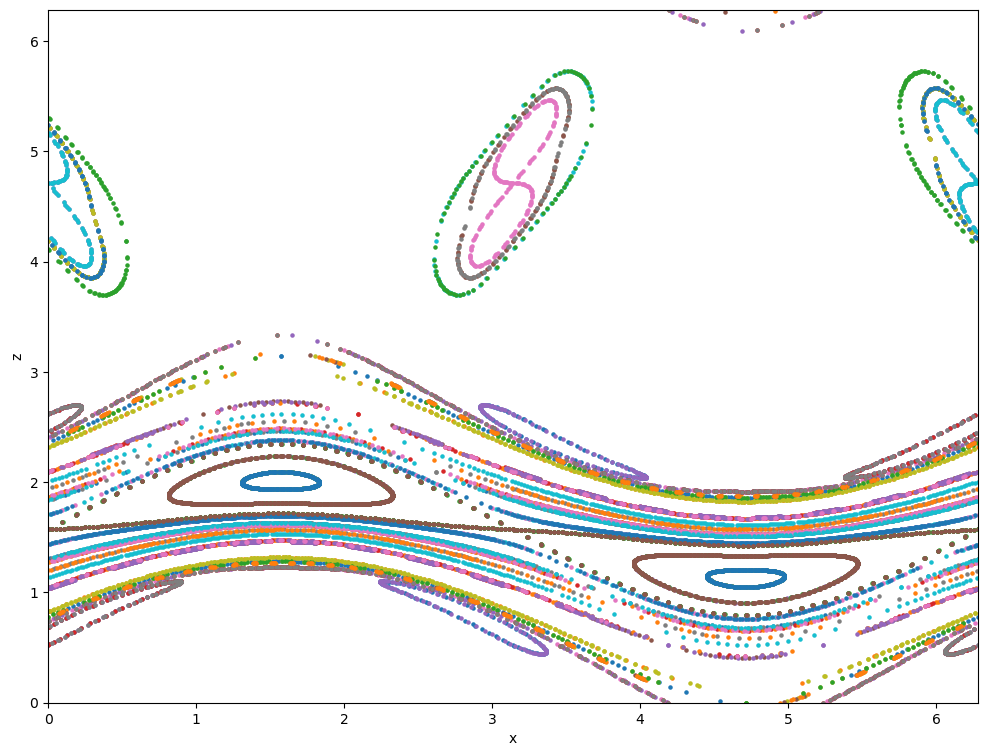Poincaré sections#
In this example, we will be using heyoka.py’s event detection feature to compute a Poincaré section for a particular case of the Arnold-Beltrami-Childress (ABC) flow. The system of ODEs reads:
and we will consider the intersection of the flow with the plane defined by \(y = 0\).
We begin as usual with the definition of the symbolic state variables \(x\), \(y\) and \(z\):
import heyoka as hy
x, y, z = hy.make_vars("x", "y", "z")
Next, we create the ODE system:
sys = [
(x, 3 / 4.0 * hy.cos(y) + hy.sin(z)),
(y, hy.cos(z) + hy.sin(x)),
(z, hy.cos(x) + 3 / 4.0 * hy.sin(y)),
]
In order to detect when the solution crosses the \(y=0\) plane, we will be using a non-terminal event. The event’s callback will compute and store in a list the value of the \(x\) and \(z\) coordinates when the solution crosses the \(y=0\) plane.
# The list of (x, z) values when the solution
# crosses the y = 0 plane.
xz_list = []
# The event's callback.
def cb(ta, t, d_sgn):
# Compute the state of the system
# at the event trigger time.
ta.update_d_output(t)
# Add the (x, z) coordinates to xz_list.
xz_list.append((ta.d_output[0], ta.d_output[2]))
# Create the non-terminal event.
ev = hy.nt_event(
# The lhs of the event equation.
y,
# The callback.
cb,
)
We can now proceed to create the integrator. We set the initial conditions to \(x=y=z=0\) (to be changed later) and we pass to the constructor the non-terminal event that we just created:
ta = hy.taylor_adaptive(sys, [0.0, 0.0, 0.0], nt_events=[ev])
We will now generate a grid of initial conditions in \(\left[0, 2\pi \right]\) for \(x\) and \(z\), and, for each set of initial conditions, we will integrate the system up to \(t=1000\). At the end of each integration, we will append to map_list the list of \(\left( x, z \right)\) coordinates at which the trajectory intersected the \(y=0\) plane:
import numpy as np
map_list = []
# Grid of 13 x 13 initial conditions.
for xg in np.linspace(0, 2 * np.pi, 13):
for zg in np.linspace(0, 2 * np.pi, 13):
# Reset time and initial conditions
# in the integrator.
ta.time = 0
ta.state[:] = [xg, 0, zg]
# Clear up xz_list.
xz_list.clear()
# Integrate up to t=1000.
ta.propagate_until(1000.0)
# Reduce the values of x and z modulo 2*pi.
xz_arr = np.mod(np.array(xz_list), np.pi * 2)
# Add the intersection points to map_list,
# if there's enough of them.
if xz_arr.shape[0] > 50:
map_list.append(xz_arr)
We can now plot the Poincaré section:
from matplotlib.pylab import plt
fig = plt.figure(figsize=(12, 9))
for m in map_list:
plt.scatter(m[:, 0], m[:, 1], s=5)
plt.xlim((0, 2 * np.pi))
plt.ylim((0, 2 * np.pi))
plt.xlabel("x")
plt.ylabel("z");


